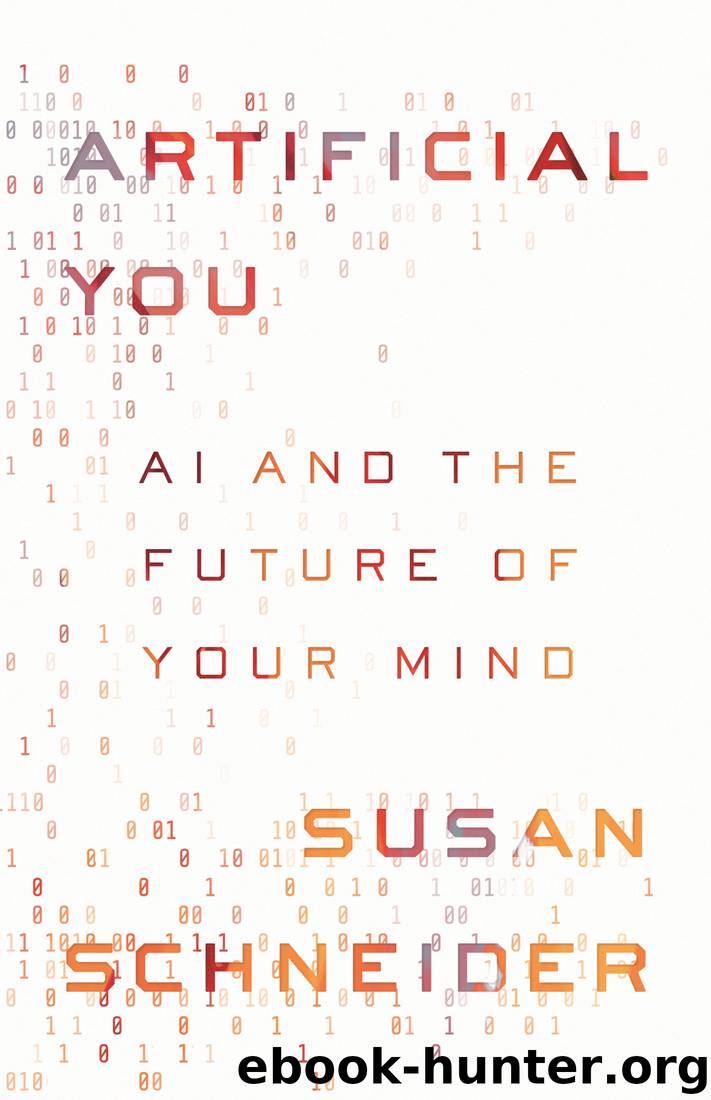Artificial You: AI and the Future of Your Mind by Susan Schneider

Author:Susan Schneider [Schneider, Susan]
Language: eng
Format: epub
Tags: Cognitive Science, Computer Science, Computers, Intelligence (AI) & Semantics, Life Sciences, Neuroscience, Philosophy, Science
ISBN: 9780691180144
Google: L8iXDwAAQBAJ
Amazon: 0691180148
Publisher: Princeton University Press
Published: 2019-09-30T16:00:00+00:00
DITCHING YOUR SUBSTRATE?
Modified patternism faces a second problem as well, one that challenges the very possibility that an individual could transfer to a different substrate, even with no cognitive or perceptual enhancements.
Suppose that it is 2050, and people are getting gradual neural regeneration procedures as they sleep. During their nightly slumbers, nanobots slowly import nanoscale materials that are computationally identical to the original materials. The nanobots then gradually remove the old materials, setting them in a small container beside the person’s bed.
By itself, this process is unproblematic for modified patternism. But now suppose there is an optional upgrade to the regeneration service for those who would like to make a backup copy of their brains. If one opts for this procedure, then during the nightly process, the nanobots take the replaced materials out of the dish and place them inside a cryogenically frozen biological brain. Suppose that by the end of the process, the materials in the frozen brain have been entirely replaced by the person’s original neurons, and they are configured the same way that they were in the original brain.
Now, suppose you choose to undergo this add-on procedure alongside your nightly regeneration. Over time, this second brain comes to be composed of the very same material as your brain originally was, configured in precisely the same manner. Which one is you? The original brain, which now has entirely different neurons, or the one with all your original neurons? The modified patternist has this to say about the neural regeneration case: You are the creature with the brain with entirely different matter, as this creature traces a continuous path through spacetime. But now, things go awry: Why is spatiotemporal continuity supposed to outweigh other factors, like being composed of the original material substrate?
Here, to be blunt, my intuitions crap out. I do not know whether this thought experiment is technologically feasible, but nevertheless, it raises an important conceptual flaw. We are trying to find out what the essential nature of a person is, so we’d like to find a solid justification for selecting one option over the other. Which is the deciding factor that is supposed to enable one to survive, in a case in which psychological continuity holds—being made of one’s original parts or preserving spatiotemporal continuity?
These problems suggest that modified patternism needs a good deal of spelling out. And remember, it wasn’t consistent with uploading in any case. The original patternist view held that one can survive uploading, but we discarded the view as deeply problematic. Until the fusion-optimist provides a solid justification for her position, it is best to view the idea of merging with AI with a good deal of skepticism. Indeed, after considering the vexing issue of persistence, perhaps we should even question the wisdom of a limited integration with AI, as middle-range enhancements are not clearly compatible with survival. Furthermore, even enhancements that merely involve the rapid or even gradual replacement of parts of one’s brain, without even enhancing one’s cognitive or perceptual skills, may be risky.
Download
This site does not store any files on its server. We only index and link to content provided by other sites. Please contact the content providers to delete copyright contents if any and email us, we'll remove relevant links or contents immediately.
| Computer Vision & Pattern Recognition | Expert Systems |
| Intelligence & Semantics | Machine Theory |
| Natural Language Processing | Neural Networks |
Algorithms of the Intelligent Web by Haralambos Marmanis;Dmitry Babenko(8517)
Test-Driven Development with Java by Alan Mellor(7330)
Data Augmentation with Python by Duc Haba(7234)
Principles of Data Fabric by Sonia Mezzetta(6977)
Learn Blender Simulations the Right Way by Stephen Pearson(6908)
Microservices with Spring Boot 3 and Spring Cloud by Magnus Larsson(6745)
RPA Solution Architect's Handbook by Sachin Sahgal(6146)
Hadoop in Practice by Alex Holmes(6026)
Jquery UI in Action : Master the concepts Of Jquery UI: A Step By Step Approach by ANMOL GOYAL(5865)
The Infinite Retina by Robert Scoble Irena Cronin(5847)
Big Data Analysis with Python by Ivan Marin(5685)
Life 3.0: Being Human in the Age of Artificial Intelligence by Tegmark Max(5395)
Pretrain Vision and Large Language Models in Python by Emily Webber(4645)
Infrastructure as Code for Beginners by Russ McKendrick(4426)
WordPress Plugin Development Cookbook by Yannick Lefebvre(4156)
Functional Programming in JavaScript by Mantyla Dan(4116)
The Age of Surveillance Capitalism by Shoshana Zuboff(4107)
Embracing Microservices Design by Ovais Mehboob Ahmed Khan Nabil Siddiqui and Timothy Oleson(3946)
Applied Machine Learning for Healthcare and Life Sciences Using AWS by Ujjwal Ratan(3918)
